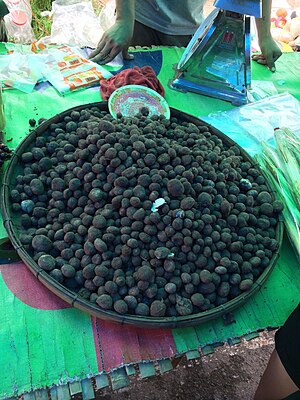Astraeus asiaticus
| Astraeus asiaticus | ||||||||||||
|---|---|---|---|---|---|---|---|---|---|---|---|---|

Astraeus asiaticus in a market in Thailand |
||||||||||||
| Systematics | ||||||||||||
|
||||||||||||
| Scientific name | ||||||||||||
| Astraeus asiaticus | ||||||||||||
| Phosri , MPMartín & Watling |
Astraeus asiaticus is a fungal art from the family of Kartoffelbovistverwandten (Sclerodermataceae) within the order of Dickröhrlingsartigen (Boletales).
features
Macroscopic features
Astraeus asiaticus forms 19–30 mm large, spherical fruiting bodies , the outer layer of which, the exopperidia , rips open in a star shape with 5–12 lobes when ripe. The exoperidia consists of several layers, is whitish and thick (≥1 mm when dry), quite stiff and granular. It expands in wet weather or rolls up again when dry (hence the German name weather stars for the genus). The inner layer becomes smoky-gray, cigar- or sepia-brown, is thick, and in ripe fruiting bodies it is cracked lengthways.
The endoperidia is sessile, almost round, 13–24 mm in diameter whitish to smoky gray and, when ripe, has an irregular opening at the tip without a distinct peristome . The actual fruit layer of the gleba is pure white in the early stage, then chestnut brown when ripe. She has no columella .
Microscopic features
The scalp consists of long, branched, intertwined hyphae that are hyaline , slightly crusty and unseptated . The hyphae measure 2.5–7.5 µm in diameter, are thin-walled or thickened with a narrow, sometimes interrupted lumen . They have buckles . The spores are spherical, 8.75–15.2 µm in diameter and ornamented with narrow, rounded, conical 0.9–1.45 µm large spines that can sometimes flow into one another.
Ecology and occurrence
Astraeus asiaticus occurs in sandy or lateritic soils in lowland forests, which are dominated by two-winged fruit trees ( Dipterocarpus ) such as Dipterocarpus tuberculatus , Dipterocarpus alatus , Dipterocarpus costatus , Dipterocarpus obtusifolius and Dipterocarpus turbinatus . Like other representatives of the potato bovine relatives, Astraeus asiaticus forms a mycorrhiza with two-winged fruit trees. It forms fruiting bodies in the rainy season from June to September. Astraeus asiaticus is next to Astraeus odoratus and Astraeus sirindhorniae the third type of weather star in Thailand. It occurs in the northern and northeastern parts.
Systematics and taxonomy
For a long time all weather stars occurring in Asia were ascribed to the common weather star ( Astraeus hygrometricus ). Phospri and colleagues realized that there were several distinguishable species. Therefore, Astraeus asiaticus was first described in 2007 by Cherdchai Phosri , María P. Martín and Roy Watling . He belongs to the genus of weather stars to the family Kartoffelbovistverwandten (Sclerodermataceae) within the order of Dickröhrlingsartigen count (Boletales). However, some authors include them in the Diplocystaceae family .
use
Astraeus asiaticus and other weather stars such as Astraeus odoratus and the common weather star are valued and sold in Thailand under the name Het phok (เห็ด เผาะ). Prices range from 30-60 Baht , but at the beginning of the season the price can rise to 300-400 Baht. Since the fungus forms a mycorrhiza with Dipterocarpus trees, it cannot be cultivated. Since it grows semi-underground, fires are often deliberately set in order to collect it better.
literature
- C. Phosri, MP Martin, P. Sihanonth, AS Whalley, R. Watling: Molecular study of the genus Astraeus. In: Mycol Res. 111 (3), 2007, pp. 275-286. doi: 10.1016 / j.mycres.2007.01.004 .
Individual evidence
- ↑ a b c d e f C. Phosri, MP Martin, P. Sihanonth, AS Whalley, R. Watling: Molecular study of the genus Astraeus . In: Mycological Research . tape 111 , 2007, p. 275-286 , doi : 10.1016 / j.mycres.2007.01.004 .
- ↑ a b PE Mortimer, SC Karunarathna, Q. Li, H. Gui, X. Yang, X. Yang, J. He, L. Ye, J. Guo, H. Li, P. Sysouphanthong, D. Zhou, J Xu, KD Hyde: Prized edible Asian mushrooms: ecology, conservation and sustainability . In: Fungal Diversity . tape 56 , 2012, p. 31-47 , doi : 10.1007 / s13225-012-0196-3 .
- ↑ a b C. Phosri, R. Watling, N. Suwannasai, A. Wilson, MP Martín: A new representative of star-shaped fungi: Astraeus sirindhorniae sp. nov. from Thailand . In: PLoS ONE . tape 9 , 2014, p. e71160 , doi : 10.1371 / journal.pone.0071160 .
- ^ Mycobank: Astraeus asiaticus . Retrieved November 9, 2016 .